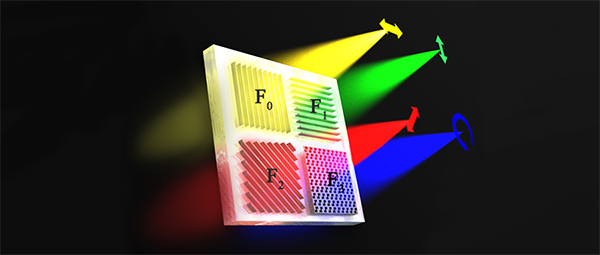Polarization state, as one of the important properties of light, is widely used in many fields, such as satellite remote sensing, astronomy, polarization imaging, chemical analysis, and biomedical diagnosis. The traditional polarization measurement methods need to rotate the optical components several times to obtain multiple images of different polarization components of the target, so it is impossible to get real-time polarization information of the dynamic target.
To solve the real-time problem, the researchers split a beam of light into multiple paths, and then use polarizers and detectors for parallel measurement, which can obtain different polarization components of the target at once.
However, the optical systems of the two methods mentioned above both have disadvantages, such as large size, complexity and high cost, and cannot be adopted to the current trend of device integration and miniaturization. Therefore, it is of great significance to use a compact, economical and high-precision optical system to achieve polarization detection.
In recent years, planar optics based on metasurface has opened up a new way for polarization detection due to its compact structure, flexible design and wide operating band. The pixelated metasurface for full-Stokes polarization detection usually integrate four or six different types of polarization filters on a single chip.
The metasurface can be used in conjunction with a photodetector imaging device CCD to obtain the polarization information of the incident light. Because each polarization filter on the metasurface corresponds to the pixel element of CCD, all of the polarization information of the incident light can be acquired through one exposure.
However, so far, it has basically remained on the measurement of the linear polarization components, that is, only the first three components of Stokes can be measured. The main reason is the lack of high performance circular polarization filter which is compatible with linear polarization filter on the same chip and can be integrated and coupled with CCD.
The research group led by Dr. C. Zhang from Shanghai Institute of Optics and Fine Mechanics, Chinese Academy of Sciences researched a high efficiency all-dielectric pixelated metasurface for full-Stokes polarization detection in near-infrared wavelength band. The research results are published in Photonics Research, Volume 9, No. 4, 2021 (C. Zhang, et al., High efficiency all-dielectric pixelated metasurface for near-infrared full-Stokes polarization detection).
The device is based on insulating silicon wafer (SOI), which not only overcomes the disadvantage of low energy utilization of metal metarsurface caused by intrinsic absorption, but also achieves the purpose of compatibility with modern mature semiconductor fabrication process.
Each unit of the polarization device consists of three linear polarization filters with the same structure but different gate line directions and one two-dimensional circular polarization filter, as shown in Fig.1. The average transmittance of TM polarized light measured by the linear polarization filter is about 75% in the wavelength band of 1.47-1.6 μm, and the extinction ratio is greater than 20 dB in the wavelength band of 1.49-1.6 μm.
The circular polarization filter adopts a two-dimensional chiral "Z" structure. The experimental results show that the average transmittance of right-handed circularly polarized light is greater than 80% in the 1.48-1.6 μm band, and the circularly polarized dichroism is as high as 70% at the wavelength of 1.6 μm.
Compared with plasmonic metasurfaces using as circular polarization filters, the energy utilization rate of the Z all-dielectric circular polarization filter is greatly improved. Besides, the two-dimensional plane structure is easy to be integrated with linear polarizationon chip, which provides conditions for full-Stokes polarization detection.
In this paper, for the first time, the design and fabrication of pixelated polarization device for full-Stokes polarization imaging are realized. In addition, further integration with CCD elements is needed to achieve full polarization imaging and a series of problems such as alignment and crosstalk between pixels during the integration process need to be studied.

Fig.1 Three-dimensional schematic of the pixel unit.
The colors are used only for distinguishment of the image and bear no wavelength information. (F0, F1, F2) and F3 represent linear polarization filters and circular polarization filters, respectively.


